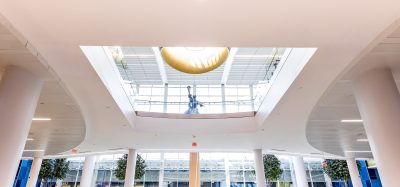Cyber-security threats and mitigations in modern airports
Posted: 6 October 2025 | Louie Orbeta | No comments yet
Trevor Strome, Director of Information Technology; and Louie Orbeta, Manager of Cyber-security and IT Infrastructure, at Winnipeg Airports Authority explore the evolving cyber risk landscape in airports, identifying key areas of concern and recommending protective measures.


Driven by “smart” technologies and digital innovation, airports today are far more than transit hubs—they are becoming complex digital ecosystems. With myriad systems ranging from biometric boarding and baggage handling and IoT-enabled facility management, airports are rapidly evolving into high-tech data-driven hubs optimised for efficiency, safety, and a smooth passenger journey.
Regardless of the aim, a successful cyber-attack may not just delay flights at a single airport, it can potentially impact global commerce, compromise sensitive data, and maybe even endanger lives.
The ongoing and accelerating process of airport digitalisation also opens the door to a growing number of potential cyber risks. As critical infrastructure, airports represent a high-value target for many types of threat actors. These threat actors range from cybercriminals seeking ransom, nation-states conducting espionage or sabotage, and even “hacktivist” groups just aiming for disruption. Regardless of the aim, a successful cyber-attack may not just delay flights at a single airport, it can potentially impact global commerce, compromise sensitive data, and maybe even endanger lives.
The evolving threat landscape
Today’s concrete-and-steel airport infrastructure is deeply infused with digital systems, built on fibre and copper networks that link a vast array of switches, servers, and systems. This digital backbone, essential to modern airport operations, is potentially vulnerable to a wide range of cyber threats which are constantly evolving in scope and sophistication. The section below explores some of the key vulnerabilities that pose a significant risk to airport systems.
Legacy systems and out-of-support software
Many airports still rely on ageing infrastructure and outdated software that may not withstand modern cyber-security threats. These legacy systems are often lacking critical security features, are no longer supported by vendors, and cannot be patched against emerging vulnerabilities. Often supporting critical airport functions, continued use of such systems significantly expands the airport’s attack surface and are potential targets for adversaries seeking to exploit unmaintained or misconfigured assets.
To address this, airports need to adopt a structured and proactive approach using a mix of the following mitigation strategies.
- Keeping a real-time inventory of hardware and software assets helps identify and track unsupported systems and ensures alignment with current security standards.
- Replacing ageing systems through phased upgrades reduces operational disruption and downtime, and provides a safer, more controlled alternative to full-scale overhauls.
- Isolating legacy systems from core infrastructure using network segmentation or air-gapping helps contain potential vulnerabilities when immediate upgrades aren’t feasible.
- Prioritising patches using the Common Vulnerability Scoring System (CVSS) and NIST Configuration Management (CM) and System Integrity (SI) controls ensures that updates are risk-driven and strategically applied, avoiding reactive or ad hoc decisions.
Ransomware and malware
Ransomware continues to be a leading threat in the cyber landscape, often entering networks because of phishing emails, compromised remote access points, or unpatched vulnerabilities. Once inside a network, modern ransomware often uses lateral movement techniques, exploits credential reuse, and disables security controls before initiating encryption. Some variants include data exfiltration capabilities, increasing the pressure with threats of public leaks. Ransomware operators also frequently target backup systems, attempting to corrupt or delete recovery points to maximise leverage. As attacks grow more targeted and sophisticated, airports must adopt a layered, technically sound defence strategy, including some of the following mitigation approaches.
- Network segmentation prevents malware from spreading laterally across systems. By isolating critical infrastructure, you contain the impact of a breach and reduce the likelihood of cross-system compromise.
- Regular and immutable backups should be performed frequently and stored in a way that prevents tampering or encryption by ransomware (such as air-gapped or offline storage). Immutable storage ensures data can be restored even if production systems are compromised.
- Endpoint Detection & Response (EDR) solutions provide real-time visibility into device behaviour, enabling rapid detection and response to suspicious activity before it escalates.
- Strict access controls enforce least-privilege principles. Limit user and system access to only what’s necessary and use multi-factor authentication (MFA) to secure privileged accounts.
- Tabletop exercises & incident response (IR) plans validate incident workflows, test decision-making procedures, and reveal weaknesses in both technical and procedural defences. Well-developed IR plans should define clear roles, escalation paths, communication protocols, and recovery objectives, ensuring teams can respond efficiently and effectively if a real incident occurs.
- Vulnerability assessments proactively identify weaknesses in systems and applications to guide patching and upgrade efforts. Regular assessments reduce the window of opportunity for ransomware to exploit known vulnerabilities.
Insider threats (malicious or negligent)
Insider threats are difficult to detect and prevent, primarily because they originate from individuals with legitimate access to systems and data. Whether through negligence, coercion, or malicious intent, trusted personnel can intentionally or unintentionally compromise sensitive information, disrupt operations, or facilitate external attacks. A layered approach combining multiple approaches is essential to manage this threat.
- Zero-trust architecture requires that every action within the network requires authentication and authorisation, reducing the risk of unchecked internal access.
- Least privilege access principles limit users to only the data and systems necessary for their role, minimising the potential impact of compromised accounts.
- User behaviour analytics (UBA) leverages AI to flag deviations from normal patterns, helping detect suspicious or malicious activity in real time, and works in concert with other security tools such as your SIEM.
- Data loss prevention (DLP) tools help monitor and block unauthorised attempts to exfiltrate sensitive information from the network.
- A formal insider threat programme combines training, behavioural monitoring, and incident response into a cohesive strategy for early detection and rapid mitigation.
Weak cyber-security culture and awareness
A strong cyber-security posture depends as much on people as it does on technology. When staff lack awareness or fail to understand the importance of secure practices, it leaves an airport vulnerable.
A strong cyber-security posture depends as much on people as it does on technology. When staff lack awareness or fail to understand the importance of secure practices, it leaves an airport vulnerable to social engineering and phishing. In an airport, even one compromised credential or careless click can open the door to serious disruption. Building a security-conscious culture is an ongoing effort that must be embedded into daily operations, training, and leadership expectations.
- Continuous security awareness programmes help teach foundational knowledge and reinforce cyber-aware behaviours across all roles, from operations to administration and equip staff with the knowledge to recognise social engineering tactics and understand their cybersecurity responsibilities.
- Simulated phishing exercises provides measurable insights into employee readiness and identifies areas where additional education is needed.
- Integrating cyber-security into the broader safety culture ensures that digital safety is treated with the same seriousness as physical safety protocols—making it a shared responsibility for everyone in the airport organisation.
Physical security of IT infrastructure
While cyber-security often focuses on digital threats, physical access remains one of the most direct and dangerous vectors for system compromise. Unauthorised entry into server rooms, communication closets, or operational technology (OT) areas can bypass digital controls entirely, possibly allowing threat actors to steal hardware, implant rogue devices, or directly manipulate/sabotage systems. In critical environments like airports, physical and cyber defences must work together to ensure complete protection of infrastructure.
- Enforcing strict physical access controls—such as badge readers, PIN codes, and biometric authentication—ensures that only authorised personnel can enter sensitive areas.
- Deploying comprehensive surveillance systems, especially when enhanced by video analytics systems, provides visibility into access attempts and supports post-incident investigation.
- Implementing the NIST Physical and Environmental Protection (PE) control family establishes structured standards for securing facilities, equipment, and environmental systems.
- Maintaining 24/7 physical monitoring, along with escorted access policies for vendors and visitors, ensures constant oversight and accountability in high-risk zones.
The future of airport cyber-security
As airports continue to evolve into digitally integrated ecosystems, the threat landscape grows more complex. Emerging risks such as AI-driven attacks and even quantum-enabled exploits will challenge traditional defences, while advancements in autonomous response, blockchain-based verification, and other tech offer new opportunities for resilience. The risks outlined above—and the mitigation strategies that accompany them—are intended to provide a practical foundation for strengthening your airport’s cyber-security posture. While no solution is one-size-fits-all, adopting a proactive, layered approach will position everyone responsible for airport cyber-security to better anticipate threats, reduce vulnerabilities, and respond with confidence when it matters most.
This article was published as part of a FREE special eReport on
‘Security airports in an evolving threat landscape 2025’.


A recognised authority in data governance, privacy-aware analytics, and strategic technology integration, Trevor helps organisations harness the power of data and AI responsibly and securely. He is the author of Healthcare Analytics for Quality and Performance Improvement and a contributor to multiple book chapters and peer-reviewed publications. As an educator and frequent speaker, he brings a pragmatic, forward-looking perspective on protecting information assets while enabling transformation in an increasingly data-centric world.


Louie’s career spans the travel, transportation, and financial sectors. Outside of work, he enjoys building cloud-powered tech projects and training for marathons and triathlons with his family.
Stay Connected with International Airport Review — Subscribe for Free!
Get exclusive access to the latest airport and aviation industry insights from International Airport Review — tailored to your interests.
✅ Expert-Led Webinars – Gain insights from global aviation leaders
✅ Weekly News & Reports – Airport innovation, thought leadership, and industry trends
✅ Exclusive Industry Insights – Discover cutting-edge technologies shaping the future of air travel
✅ International Airport Summit – Join our flagship event to network with industry leaders and explore the latest advancements
Choose the updates that matter most to you.
Sign up now to stay informed, inspired, and connected — all for free!
Thank you for being part of our aviation community. Let’s keep shaping the future of airports together!
Related topics
Artificial intelligence (AI), Biometrics, Cyber-security, Digital transformation, Innovation, New technologies, Security, Workforce


















